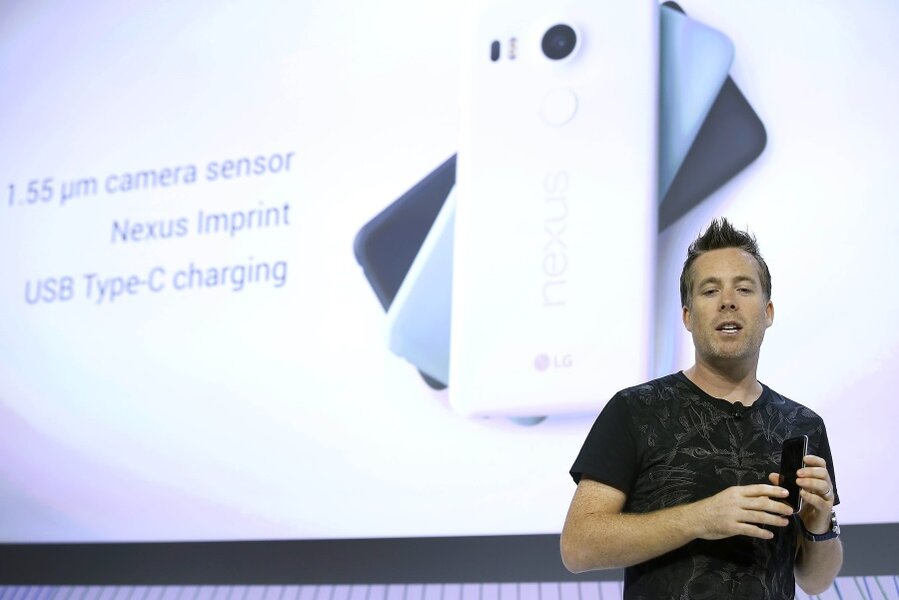Google's latest Nexus phones: What are the key features?
Loading...
Google revealed two new flagship Android phones at a media event today in San Francisco: the Nexus 5X and the Nexus 6P. The two phones – the first made by LG, the second by Huawei – will be the first to ship with the latest Android operating system, 6.0 “Marshmallow.”
Nexus handsets have never been quite as popular as Samsung’s Galaxy series or HTC’s One phones, but for those who want to live on the bleeding edge of Android, they’re as good as smartphones get. Unlocked Nexus phones can be bought directly from Google, so they run “pure” Android, rather than slightly modified versions with additional software available from wireless carriers.
The Nexus 6P could be mistaken for an iPhone 6 Plus at first glance: its body is made of anodized aluminum and is just 7.3 mm thick. The phone’s 5.7-inch display takes up nearly the entire front of the device – there’s almost no bezel around the edges. Rather than the traditional micro-USB port, the Nexus 6P uses a reversible USB Type-C port (the same kind found on the 2015 Macbook), which, Google says, will allow it to charge twice as fast as an iPhone 6 Plus.
The Nexus 6P also includes a built-in fingerprint scanner called “Nexus Imprint.” Once the scanner has been calibrated, it’s able to recognize fingerprints in just over half a second, Android exec Dave Burke announced at the event. Fingerprints can be used to unlock the phone or authorize purchases from the Google Play Store.
The Nexus 5X is a slightly smaller handset with a 5.2-inch display, but it also has the Nexus Imprint fingerprint scanner and a USB Type-C port. The cameras in both the 6P and the 5X have been optimized for indoor and low-light photography, Google said, by including sensors with huge 1.55 micron pixels. Larger sensors mean the phones’ cameras should be able to take photos with better dynamic range and less noise, though real-world performance depends on a host of factors. The cameras in both phones include laser-detect autofocus, and can take video in super-high-definition 4K resolution or in slow-motion.
The Nexus 6P and 5X include a new feature called Android Sensor Hub, which uses information such as orientation and speed to detects what the phone is doing without having to draw on the main processor. Android Sensor Hub knows when the phone is picked up, for example, so it can quickly display notifications and turn on necessary sensors, without having to go into full-power mode. Android Sensor Hub should help the phones save battery power, Google said at the event.
The Nexus 6P and 5X will ship running Android 6.0 “Marshmallow,” which introduces a few nifty improvements that were shown earlier this year at Google’s I/O conference. Apps now ask for permissions on an as-needed basis, rather than presenting users with a single long list of permissions when they’re installed. Android 6.0 Marshmallow also includes a “Doze” mode that tells apps to hibernate when the phone hasn’t been moved in a while. Google says that in its tests, Doze mode resulted in 30 percent longer battery life on existing Nexus 5 and 6 devices.
In some ways, Marshmallow copies iOS software – a-la-carte app permissions have been available on iPhones and iPads for years, and the fingerprint reader found on the Nexus 6P and 5X is similar to the one found on the iPhone 5S, 6, and 6 Plus – but in other ways, it improves upon it. Google Now On Tap, for example, interprets input within the context of whatever app is open, allowing users to quickly find out information about a currently playing song or a restaurant that's open in a web page.
Marshmallow will roll out next week to all Nexus 5 and Nexus 6 phones, the Nexus 7 and Nexus 9 tablets, and the Nexus Player streaming media box.
Both new phones are available for preorder starting on Tuesday in the US, UK, Ireland, and Japan. The Nexus 5X starts at $379 and comes in Carbon Black, Sports White, and Ice Blue colors, while the Nexus 6P starts at $499 and comes in Frost White, aluminum, and graphite finishes. The phones will be sold unlocked, so they can be used with any major wireless carrier’s network, including Google’s own Project Fi service.








